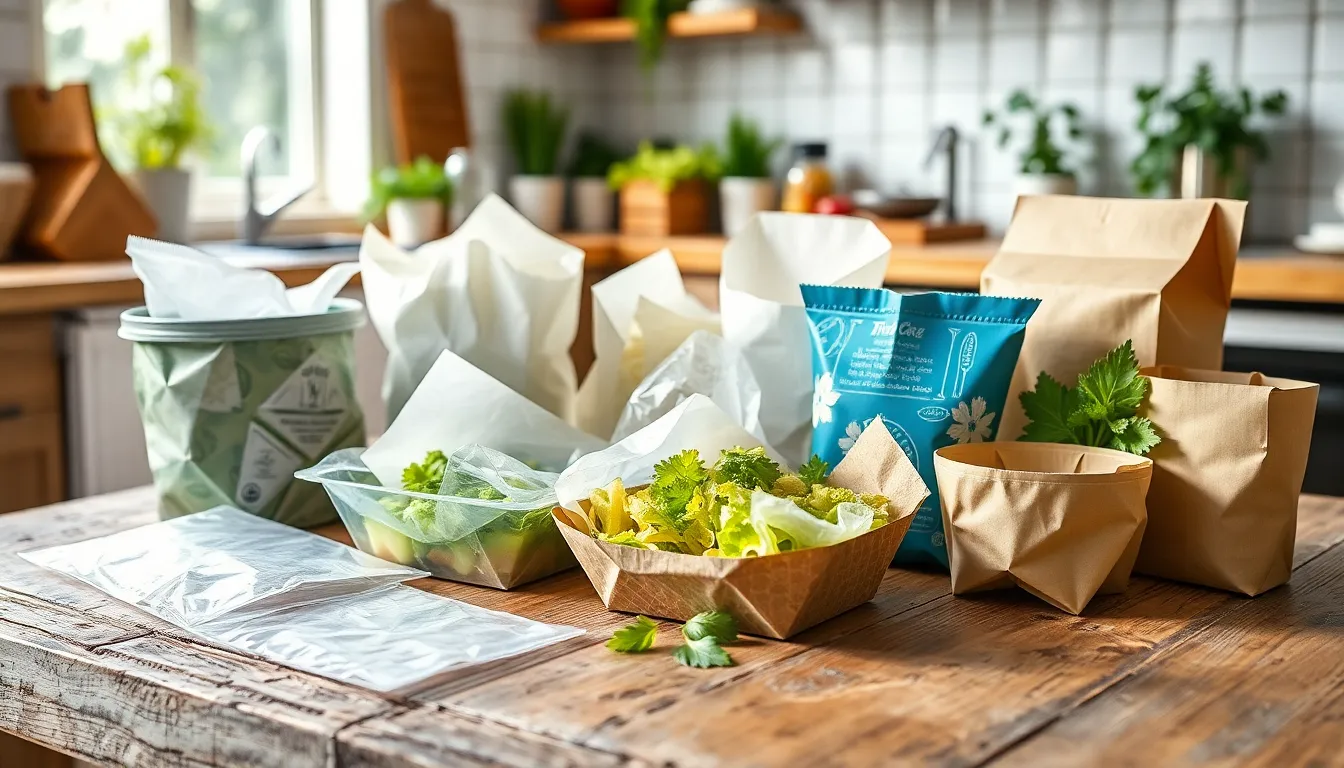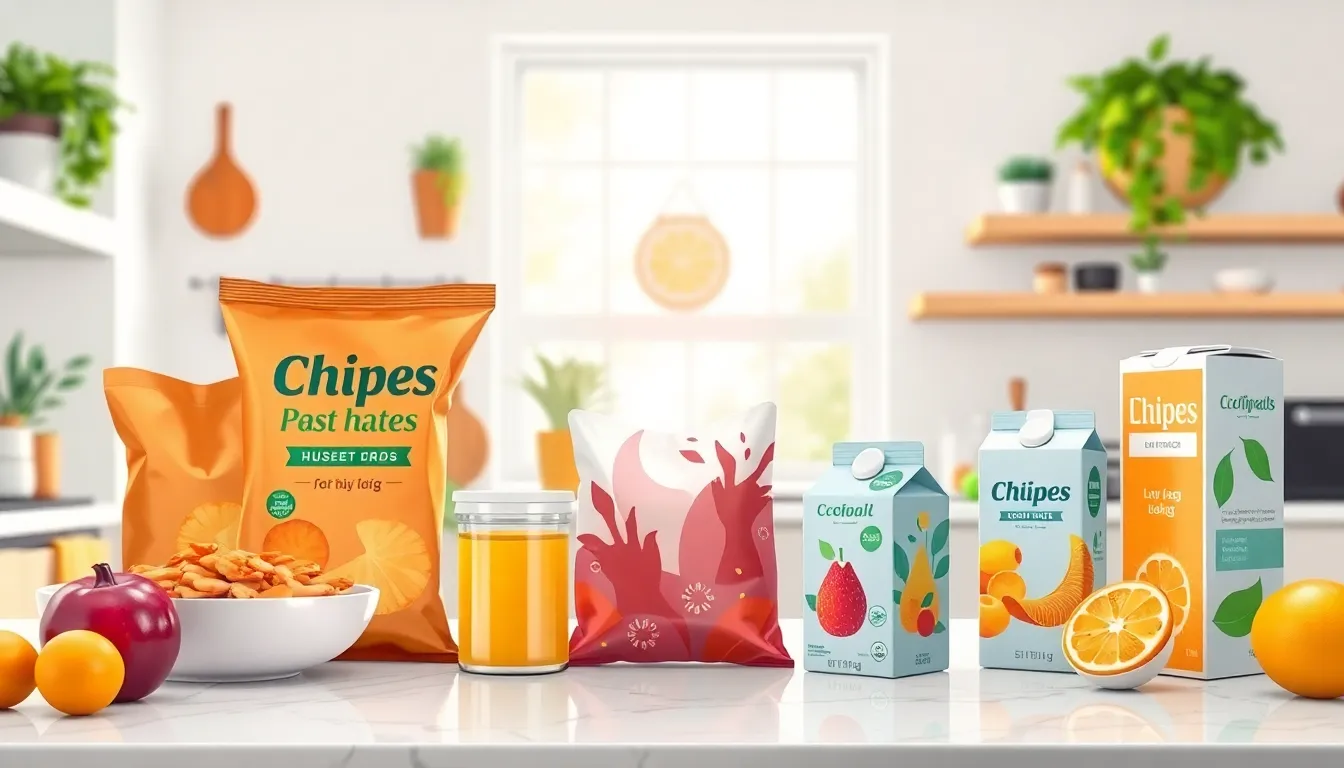In a world where first impressions matter, food packaging has become the unsung hero of the culinary universe. It’s not just about keeping food fresh anymore—it’s about making a statement. Picture this: a bag of chips that practically screams “Crunch me!” or a juice carton that looks so chic it could grace the cover of a magazine. Food packaging trends are evolving faster than you can say “organic quinoa,” and they’re here to capture attention while keeping our snacks safe.
From eco-friendly materials to eye-catching designs, the latest trends in food packaging are all about marrying functionality with flair. As consumers become more conscious about sustainability, brands are stepping up their game to deliver not just food, but a whole experience. Buckle up as we dive into the deliciously innovative world of food packaging trends that are reshaping what we see on grocery shelves and, let’s be honest, making our taste buds tingle with anticipation.
Table of Contents
ToggleOverview of Food Packaging Trends
Food packaging trends reflect the changing preferences of consumers and advancements in technology. Eco-friendly materials lead the charge, as brands prioritize sustainability. Biodegradable, compostable, and recyclable materials gain traction, with plant-based plastics and paperboard alternatives becoming prevalent.
Vibrant and innovative designs contribute to the consumer experience. Eye-catching graphics and bold colors attract attention, while minimalist designs convey sophistication. Personalization in packaging allows brands to connect with consumers, creating a sense of ownership through customizable options.
Smart packaging technology enhances food safety and freshness. Sensors integrated into packaging provide real-time data on temperature, humidity, and freshness levels. This innovation informs consumers about the product’s condition, promoting trust and reducing food waste.
Convenience remains a top priority, with packaging formats that cater to on-the-go lifestyles. Ready-to-eat meals, portion-controlled servings, and resealable packages address the evolving consumption habits of busy consumers.
Cultural influences shape packaging trends as well. Authenticity in branding aligns with consumer desires for transparency and ethical sourcing. Packaging that communicates local ingredients or heritage stories resonates with consumers seeking meaningful connections to their food.
Overall, these trends highlight the dynamic landscape of food packaging, where sustainability, design, technology, convenience, and cultural relevance intertwine. Brands adapting to these developments position themselves to thrive in a competitive market, while meeting consumer demands for responsible and engaging packaging solutions.
Innovative Materials in Food Packaging

Innovative materials are reshaping food packaging, driving sustainability and enhancing consumer appeal. These advancements not only address environmental concerns but also respond to consumer preferences for engaging and safe packaging.
Biodegradable and Compostable Materials
Biodegradable and compostable materials are gaining traction in food packaging. Such materials break down naturally, reducing landfill waste. Brands are increasingly using options like polylactic acid (PLA), derived from cornstarch, and paper-based materials that decompose more quickly than traditional plastics. For example, some snack brands now package products in biodegradable wrappers, directly addressing eco-conscious consumers’ preferences. Companies benefit from improved brand image while contributing to a circular economy.
Sustainable Plastics
Sustainable plastics, including those made from recycled materials, are transforming packaging options. These plastics, often labeled as rPET (recycled polyethylene terephthalate), reuse post-consumer waste, lowering the demand for new plastic production. Leading beverage companies are adopting rPET for bottles, promoting a responsible packaging cycle. Innovative bioplastics, such as those extracted from plants, also offer alternatives that reduce reliance on fossil fuels. This transition not only meets regulatory requirements but also aligns with growing consumer demand for sustainability in product choices.
Technological Advancements
Technological advancements significantly impact food packaging, enhancing safety and consumer engagement. These innovations align with the growing demand for convenience and sustainability in the culinary market.
Smart Packaging Solutions
Smart packaging solutions utilize sensors and RFID technology to monitor food conditions. These features provide real-time data on temperature, humidity, and spoilage, ensuring optimal freshness. For instance, intelligent labels signal when food is nearing expiration, reducing waste and enhancing safety. Brands leverage this technology to foster transparency and build trust with consumers, as smart packaging communicates essential information directly to them. By integrating QR codes, consumers access detailed product information and sustainability efforts, offering a deeper connection to the brand.
Active Packaging Technologies
Active packaging technologies involve incorporating materials that actively interact with food products. Antimicrobial films, for example, extend shelf life by preventing microbial growth. Oxygen scavengers absorb excess gases, maintaining product quality and freshness. Additionally, moisture control systems regulate humidity levels, crucial for products like baked goods. These technologies not only enhance food safety but also contribute to minimizing waste. As innovations evolve, active packaging becomes a key component in effective food preservation, aligning with sustainability goals by reducing the need for preservatives and excess materials.
Consumer Preferences and Behavior
Consumer preferences increasingly drive food packaging trends. Sustainability, aesthetics, and convenience play significant roles in shaping these preferences.
Eco-Friendly Packaging Choices
Eco-friendly packaging choices continue to resonate with consumers. Brands adopt biodegradable materials, such as polylactic acid (PLA) and paper, to minimize environmental impact. Recyclable options, including recycled PET (rPET), address the rising demand for sustainability. A survey by Nielsen indicates that 81% of consumers prioritize sustainable brands, while 73% are willing to pay a premium for eco-friendly packaging. Companies emphasizing sustainability cultivate loyalty and appeal to environmentally conscious shoppers.
Aesthetic Appeal in Food Packaging
Aesthetic appeal influences consumer purchasing decisions significantly. Vibrant graphics and minimalist designs capture attention on shelves, enhancing brand visibility. Research shows that products with attractive packaging can increase sales by up to 30%. Consumers associate well-designed packaging with quality and brand credibility. Personalized designs also foster emotional connections, encouraging repeat purchases. Brands that effectively balance aesthetics and functionality enhance consumer experiences, making a memorable first impression.
Regulatory Changes and Standards
Regulatory changes and standards significantly impact food packaging trends, ensuring safety, sustainability, and consumer transparency. Agencies like the Food and Drug Administration (FDA) and the Environmental Protection Agency (EPA) establish guidelines that govern materials and processes in food packaging.
Key Regulations
- Material Safety: The FDA sets safety standards for materials used in food packaging, prohibiting harmful substances and ensuring that packaging does not alter food quality.
- Labeling Requirements: Accurate labeling regulations require clear information on ingredients, nutritional facts, and allergen warnings, allowing consumers to make informed choices.
- Sustainability Standards: The EPA promotes initiatives aimed at reducing waste, encouraging the use of recyclable materials and eco-friendly alternatives in packaging.
Recent Trends in Compliance
- Bioplastics: Regulations are adapting to include bioplastics, which require approval and testing to confirm they’re safe for food contact and meet sustainability criteria.
- Recycling Initiatives: Many jurisdictions are enacting laws to mandate specific materials for recyclability. Brands must comply by using easily recyclable designs and materials.
- Consumer Education: Transparency initiatives aim to educate consumers on proper disposal methods and recycling, fostering responsible consumer behavior and enhancing brand trust.
Impact of Compliance
Compliance with these regulations helps brands avoid fines and encourages sustainable practices. As consumers increasingly favor brands that align with environmental values, adherence to these standards significantly enhances brand reputation and sales potential. Embracing changing regulations allows brands to remain competitive, respond to consumer demands, and contribute positively to environmental sustainability.
The landscape of food packaging is rapidly evolving as brands adapt to consumer demands for sustainability and aesthetic appeal. Innovations in materials and design are not just enhancing the visual experience but also prioritizing environmental responsibility.
As smart technologies and convenient formats take center stage, brands are finding new ways to ensure freshness and safety while minimizing waste. The focus on cultural relevance and authenticity further deepens the connection between consumers and their food choices.
Staying ahead in this competitive market requires brands to embrace these trends and align with the values of today’s eco-conscious consumers. The future of food packaging promises to be as exciting as it is responsible.



